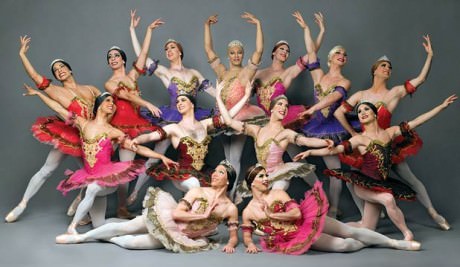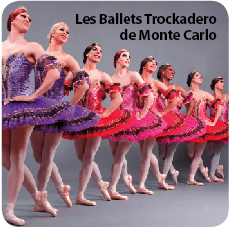I have attended in the past year an American Ballet Theatre Production at The Kennedy Center, Matthew Bourne’s Swan Lake in the Big Apple, a Boshoi Ballet HD Production at a local movie theater, and now a night with the most talented ballet company of all – Les Ballets Trockadero (“Trocks”). It’s very different in a Trock Audience since the patrons are witnesses to real ballet – and professional ballet dancers – which has been exaggerated and modified to engage your sense of humor. And, no, it’s not A Chorus Line’s “Dance 10, Looks 3”- it’s “Dance 10, Looks 10.” More about that later! Read on as you discover why a sold-out diversified audience packed the Center tonight for an evening of Trock.

Before the performance, the venue hosted an informative thirty-minute chat with one of the troupe’s managers. Tonight’s guest lecturer was Trocks Ballet Master Paul Ghiselin, who joined the organization in 1995 as a performer and graduated to the position of full-time Ballet Master in 2007. After an interesting introduction, he took questions from the almost 200 people who had arrived early to take advantage of this educational opportunity. The following historical information was provided by Paul:
The Trocks are a ballet troupe comprised of 15 male dancers. They began in New York City meeting in friends’ basements in the early 70s and after much demand from their followers they switched to a full time professional organization in 1974. What makes them different, as well as successful, is their ability to take serious ballets and give it that Trock touch. They now understand that it is easier to make a serious ballet funny through embellishment that to make a humorous ballet funnier. The movements are compatible to the actual ballet but are modified to incorporate the humor, which are combined with the choreography to make it appear spontaneous.
Most dancers can dance either the female or male role evidenced by the program which lists each actor’s male and female name. Make-up application must be accomplished within 75 minutes; that’s what the schedule emphatically requires. The Trocks have also learned with their constant world-wide travels and tight accommodations, the type of performer that is most respected is one that honors teamwork rather than individuality.
The evening was divided into three Acts. The first act was Chopiniana with music by Frederick Chopin. The piece included seven different Chopin masterpieces consisting of Nocturnes, Valses, Preludes, and Mazurkas, and was the longest of the evening’s presentations. The Nocturne began with eight ballerinas spread around the stage and three in the very back. All of a sudden, another ballerina entered from stage right and walks over to the group of three in the back signaling that she is replacing one of them. She politely taps one of the three on the shoulder using hand gestures indicating his departure. The replaced ballerina dances off the stage, throwing her hands up in disgust while her replacement continues in the new role as if she was there from the outset. As the piece continues, dancers kick others during their Enchaînements, who are thrown off balance while the action continues without disturbing the movement of others.
I am beginning to realize that the Trocks’ intentional humor is working well. The Battement frappes and Demi-pliés continue on stage without interruption. Then, during her last dance routine, one of the ballerinas falls off the stage. She returns to the exact position before she fell as if the audience hadn’t noticed the disaster. At the end of Act I, the company’s Master of Ceremonies comes on stage with flowers for the principal female ballerina and a bottle of wine for the male. The female smells the flowers, looks at the bottle of wine given to her partner, and examines the flowers again. As the curtain is dropping, you see the male looking at the wine’s ingredients and the female grabbing the bottle, throwing the flowers in the male’s hand and providing a sense of facial triumph. The audience is on the floor by this point laughing over the brouhaha that they just witnessed. Are you beginning to get the picture?
Merce Cunningham’s Pas de Deux began Act II followed by Go for Barocco consisting of music by J.S. Bach.
“Walpurgis Night” is Act III, which was inspired by the Bolshoi Ballet’s Valpurgeyeva Noch, was my favorite. Humorous antics continued on stage as the audience marveled over the precision and aplomb of what was provided by the ballerina extravaganza. The backdrop of the last set included a moon and a Greek dome with seven columns, which was definitely one of the most elaborate backdrops utilized during the evening. It was easier to distinguish who played the roles of the male and female ballerinas, since the males wore ingenious costumes that exposed their chests. It must have been very hot on stage with the spotlights since one observed the sweat that was pouring down from their chests with ripped abs and minimal body fat. The chiseled muscles were necessary assets needed in the numerous lifts that were exhibited during the entire performance.
You definitely need to mark your calendar when Les Ballets Trockadero is scheduled to perform in the area again.
Running time: approximately two hours, with two 15-minute intermissions.
Les Ballets Trockadero de Monte Carlo performed for one night only on Saturday, May 4, 2013, at George Mason University’s Center for the Arts – 4400 University Drive, in Fairfax, Virginia. Although this is the final show for the Center’s entire season, it’s not too early to begin reviewing their 2013-2014 season by checking their event calendar.
LINK
Les Ballets Trockadero de Monte Carlo website.





